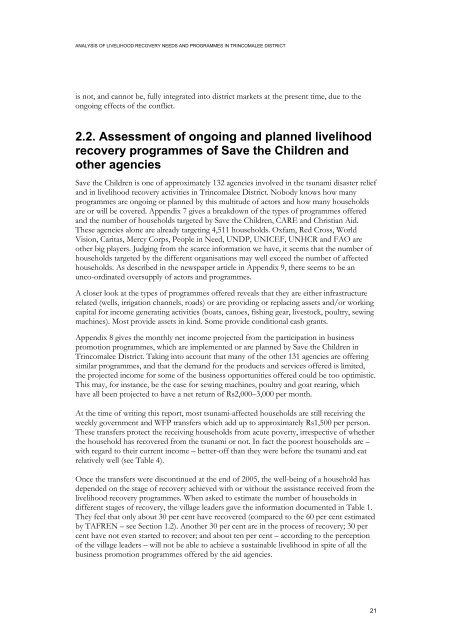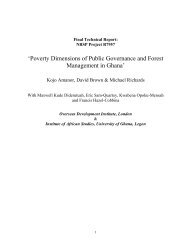Feasibility study on a capital-based income generation scheme for ...
Feasibility study on a capital-based income generation scheme for ...
Feasibility study on a capital-based income generation scheme for ...
You also want an ePaper? Increase the reach of your titles
YUMPU automatically turns print PDFs into web optimized ePapers that Google loves.
ANALYSIS OF LIVELIHOOD RECOVERY NEEDS AND PROGRAMMES IN TRINCOMALEE DISTRICT<br />
is not, and cannot be, fully integrated into district markets at the present time, due to the<br />
<strong>on</strong>going effects of the c<strong>on</strong>flict.<br />
2.2. Assessment of <strong>on</strong>going and planned livelihood<br />
recovery programmes of Save the Children and<br />
other agencies<br />
Save the Children is <strong>on</strong>e of approximately 132 agencies involved in the tsunami disaster relief<br />
and in livelihood recovery activities in Trincomalee District. Nobody knows how many<br />
programmes are <strong>on</strong>going or planned by this multitude of actors and how many households<br />
are or will be covered. Appendix 7 gives a breakdown of the types of programmes offered<br />
and the number of households targeted by Save the Children, CARE and Christian Aid.<br />
These agencies al<strong>on</strong>e are already targeting 4,511 households. Oxfam, Red Cross, World<br />
Visi<strong>on</strong>, Caritas, Mercy Corps, People in Need, UNDP, UNICEF, UNHCR and FAO are<br />
other big players. Judging from the scarce in<strong>for</strong>mati<strong>on</strong> we have, it seems that the number of<br />
households targeted by the different organisati<strong>on</strong>s may well exceed the number of affected<br />
households. As described in the newspaper article in Appendix 9, there seems to be an<br />
unco-ordinated oversupply of actors and programmes.<br />
A closer look at the types of programmes offered reveals that they are either infrastructure<br />
related (wells, irrigati<strong>on</strong> channels, roads) or are providing or replacing assets and/or working<br />
<strong>capital</strong> <strong>for</strong> <strong>income</strong> generating activities (boats, canoes, fishing gear, livestock, poultry, sewing<br />
machines). Most provide assets in kind. Some provide c<strong>on</strong>diti<strong>on</strong>al cash grants.<br />
Appendix 8 gives the m<strong>on</strong>thly net <strong>income</strong> projected from the participati<strong>on</strong> in business<br />
promoti<strong>on</strong> programmes, which are implemented or are planned by Save the Children in<br />
Trincomalee District. Taking into account that many of the other 131 agencies are offering<br />
similar programmes, and that the demand <strong>for</strong> the products and services offered is limited,<br />
the projected <strong>income</strong> <strong>for</strong> some of the business opportunities offered could be too optimistic.<br />
This may, <strong>for</strong> instance, be the case <strong>for</strong> sewing machines, poultry and goat rearing, which<br />
have all been projected to have a net return of Rs2,000–3,000 per m<strong>on</strong>th.<br />
At the time of writing this report, most tsunami-affected households are still receiving the<br />
weekly government and WFP transfers which add up to approximately Rs1,500 per pers<strong>on</strong>.<br />
These transfers protect the receiving households from acute poverty, irrespective of whether<br />
the household has recovered from the tsunami or not. In fact the poorest households are –<br />
with regard to their current <strong>income</strong> – better-off than they were be<strong>for</strong>e the tsunami and eat<br />
relatively well (see Table 4).<br />
Once the transfers were disc<strong>on</strong>tinued at the end of 2005, the well-being of a household has<br />
depended <strong>on</strong> the stage of recovery achieved with or without the assistance received from the<br />
livelihood recovery programmes. When asked to estimate the number of households in<br />
different stages of recovery, the village leaders gave the in<strong>for</strong>mati<strong>on</strong> documented in Table 1.<br />
They feel that <strong>on</strong>ly about 30 per cent have recovered (compared to the 60 per cent estimated<br />
by TAFREN – see Secti<strong>on</strong> 1.2). Another 30 per cent are in the process of recovery; 30 per<br />
cent have not even started to recover; and about ten per cent – according to the percepti<strong>on</strong><br />
of the village leaders – will not be able to achieve a sustainable livelihood in spite of all the<br />
business promoti<strong>on</strong> programmes offered by the aid agencies.<br />
21
















